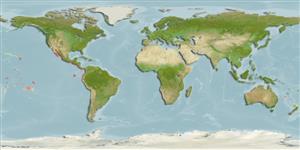Common names from other countries
Environment: milieu / climate zone / depth range / distribution range
Ekologi
Pelagis, permukaan; kisaran kedalaman 0 - 20 m (Ref. 83938). Tropical
Eastern Pacific.
Length at first maturity / Size / Weight / umur
Maturity: Lm ? range ? - ? cm Max length : 17.4 cm TL (female)
Pelagic. Mating behavior unknown. On contact with the female, presumably the male autotomizes the hectocotylus. Multiple hectocotyli can persist in the mantle cavities of females for extended periods. Eggs of up to three different developmental stages may be present within a single shell. Large numbers of females have been observed at the surface in open-ocean during daylight hours. Females may attach to each other, forming large chains of up to 18 individuals. Females are known to strand on beaches in the southern Gulf of California, Mexico, during late winter and early spring (January to March) (Ref 96968) (Ref. 83938).
Life cycle and mating behavior
Kematangan | Reproduksi, perkembang biakan | Pemijahan | telur-telur | Fecundity | Larva
Members of the class Cephalopoda are gonochoric. Male and female adults usually die shortly after spawning and brooding, respectively. Mating behavior: Males perform various displays to attract potential females for copulation. During copulation, male grasp the female and inserts the hectocotylus into the female's mantle cavity where fertilization usually occurs. Life cycle: Embryos hatch into planktonic stage and live for some time before they grow larger and take up a benthic existence as adults.
rujukan utama
Acuan | Koordinator | mitra
Hochberg, F.G. and Y.E. Camacho-García. 2009. (Ref. 83938)
Status IUCN Red List (Ref. 130435)
status CITES (Ref. 108899)
Not Evaluated
Not Evaluated
penggunaan manusia
| FishSource |
Alat, peralatan
informasi lanjut
Umur / Saiz
Pertumbuhan
panjang-berat
panjang-panjang
Morfologi
Larva
Kelimpahan
Sumber internet
Estimates based on models
Preferred temperature
(Ref.
115969): 19 - 28.9, mean 25.1 (based on 357 cells).
kategori harga
Unknown.
